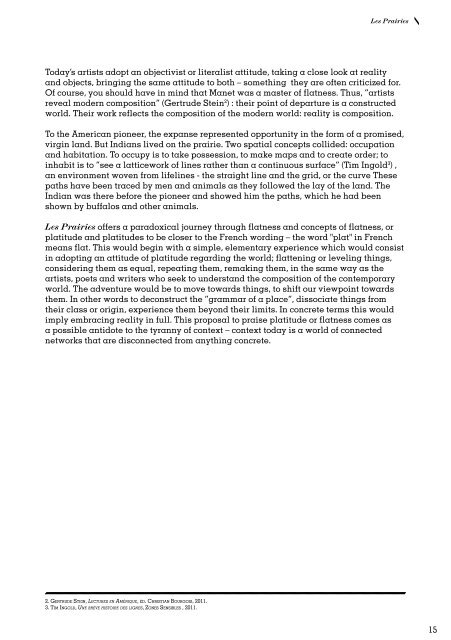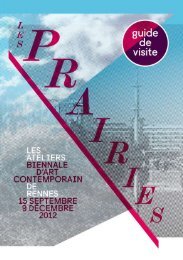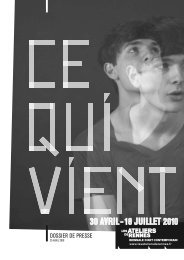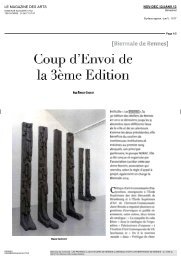Download here the Visitor's guide. - Les Ateliers de Rennes
Download here the Visitor's guide. - Les Ateliers de Rennes
Download here the Visitor's guide. - Les Ateliers de Rennes
You also want an ePaper? Increase the reach of your titles
YUMPU automatically turns print PDFs into web optimized ePapers that Google loves.
<strong>Les</strong> Prairies<br />
Today’s artists adopt an objectivist or literalist attitu<strong>de</strong>, taking a close look at reality<br />
and objects, bringing <strong>the</strong> same attitu<strong>de</strong> to both – something <strong>the</strong>y are often criticized for.<br />
Of course, you should have in mind that Manet was a master of flatness. Thus, “artists<br />
reveal mo<strong>de</strong>rn composition” (Gertru<strong>de</strong> Stein 2 ) : <strong>the</strong>ir point of <strong>de</strong>parture is a constructed<br />
world. Their work reflects <strong>the</strong> composition of <strong>the</strong> mo<strong>de</strong>rn world: reality is composition.<br />
To <strong>the</strong> American pioneer, <strong>the</strong> expanse represented opportunity in <strong>the</strong> form of a promised,<br />
virgin land. But Indians lived on <strong>the</strong> prairie. Two spatial concepts colli<strong>de</strong>d: occupation<br />
and habitation. To occupy is to take possession, to make maps and to create or<strong>de</strong>r; to<br />
inhabit is to “see a latticework of lines ra<strong>the</strong>r than a continuous surface” (Tim Ingold 3 ) ,<br />
an environment woven from lifelines - <strong>the</strong> straight line and <strong>the</strong> grid, or <strong>the</strong> curve These<br />
paths have been traced by men and animals as <strong>the</strong>y followed <strong>the</strong> lay of <strong>the</strong> land. The<br />
Indian was t<strong>here</strong> before <strong>the</strong> pioneer and showed him <strong>the</strong> paths, which he had been<br />
shown by buffalos and o<strong>the</strong>r animals.<br />
<strong>Les</strong> Prairies offers a paradoxical journey through flatness and concepts of flatness, or<br />
platitu<strong>de</strong> and platitu<strong>de</strong>s to be closer to <strong>the</strong> French wording – <strong>the</strong> word "plat" in French<br />
means flat. This would begin with a simple, elementary experience which would consist<br />
in adopting an attitu<strong>de</strong> of platitu<strong>de</strong> regarding <strong>the</strong> world; flattening or leveling things,<br />
consi<strong>de</strong>ring <strong>the</strong>m as equal, repeating <strong>the</strong>m, remaking <strong>the</strong>m, in <strong>the</strong> same way as <strong>the</strong><br />
artists, poets and writers who seek to un<strong>de</strong>rstand <strong>the</strong> composition of <strong>the</strong> contemporary<br />
world. The adventure would be to move towards things, to shift our viewpoint towards<br />
<strong>the</strong>m. In o<strong>the</strong>r words to <strong>de</strong>construct <strong>the</strong> “grammar of a place”, dissociate things from<br />
<strong>the</strong>ir class or origin, experience <strong>the</strong>m beyond <strong>the</strong>ir limits. In concrete terms this would<br />
imply embracing reality in full. This proposal to praise platitu<strong>de</strong> or flatness comes as<br />
a possible antidote to <strong>the</strong> tyranny of context – context today is a world of connected<br />
networks that are disconnected from anything concrete.<br />
2. Ge r t r u d e St e i n, le c t u r e s e n Am é r i q u e, é d. Ch r i S t i a n Bo u r G o i S, 2011.<br />
3. Tim in g o l d, un e b r è v e histoire d e s l i g n e s, Zo n e S Se n S i B l e S , 2011.<br />
15






